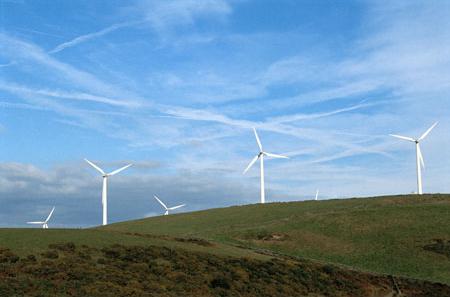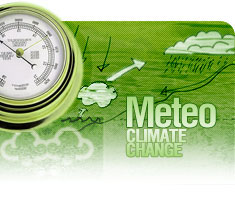Reducing emissions.
Burning oil and coal more efficiently, switching to renewable forms of energy, such as solar and wind power, and developing new technologies for industry and transport can attack the problem at the source.
Getting more electricity, transport, and industrial output for less coal, oil, or gasoline is a no-lose situation: more profit, less pollution, less global warming. . . although initial outlays for better equipment and technology can be expensive.
Most of the immediate progress that can be made to reduce greenhouse-gas emissions involves using fossil fuels more efficiently. The savings realized this way will buy time for the global climate system while alternative-energy technologies can be developed and made cost-effective. It is hoped that emissions-free sources ultimately will replace fossil fuels as the main category of energy supply.
"Combined-cycle" turbines -- in which the heat from burning fuel drives steam turbines while the thermal expansion of the exhaust gases drives gas turbines -- can boost the efficiency of electricity generation by 70 per cent. In the longer term, new technologies could double the efficiency of power plants.
Gasoline fuel cells and other advanced automotive technologies can cut carbon-dioxide emissions from transport roughly in half, as can "hybrid" gas/electricity vehicles, some of which are already on the market. Cutting fossil fuel use while maintaining economic growth will be a major challenge.

Natural gas releases less carbon dioxide per unit of energy than coal or oil. Hence, switching to natural gas is a quick way to cut emissions.
Industry, which accounts for over 40 per cent of global carbon-dioxide emissions, can benefit from combined heat and power co-generation, other uses of waste heat, improved energy management, and more efficient manufacturing processes.
Installing more efficient lighting and appliances in buildings can significantly cut electricity use. Improving building insulation can greatly reduce the amount of fuel needed for heating or air conditioning.
Taking advantage of existing renewable energy technologies.
Solar energy and wind-generated electricity -- at current levels of efficiency and cost -- can replace some fossil-fuel use, and are increasingly being used. Greater employment of such technologies can increase their efficiencies of scale and lower their costs. The current contribution of such energy-producing methods to world supplies is less than 2 per cent. Expansion of hydro-electric power, where appropriate, could make a major contribution to lowering greenhouse-gas emissions but the use of hydropower is necessarily limited by its impacts on human settlements and river systems. Wind turbines may partially replace fuel-powered electricity generation. Biomass sources of energy -- such as fuelwood, alcohol fermented from sugar, combustible oils extracted from soybeans, and methane gas emitted by waste dumps -- can help cut greenhouse gas emissions, but only if vegetation used for the purpose is replaced by equal amounts of replanted vegetation (so that the carbon dioxide released by biomass combustion is recaptured through photosynthesis). Nuclear energy produces virtually no greenhouse gases, but public concern over safety, transport and disposal of radioactive wastes -- not to mention weapons proliferation -- means that the responsible employment of nuclear power will likely reain limited. It now accounts for about 6.8 per cent of global energy supplies. New technologies have become available for "capturing" the carbon dioxide emitted by fossil-fuel power plants before it reaches the atmosphere. The carbon dioxide is then stored underground in empty oil or gas reservoirs, unused coal beds, or in the deep ocean. While not exactly "renewable," this approach, which is already in limited use, is being scrutinized for possible risks and environmental impacts. Source: http://unfccc.int/essential_background/feeling_the_heat/items/2908.php



 Română
Română English
English


